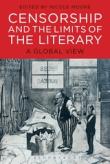AustLit
Latest Issues
AbstractHistoryArchive Description
'Though literature and censorship have been conceived as long-time adversaries, this collection seeks to understand the degree to which they have been dialectical terms, each producing the other, coeval and mutually constitutive.
On the one hand, literary censorship has been posited as not only inescapable but definitive, even foundational to speech itself. One the other, especially after the opening of the USSR's spekstrahn, those enormous collections of literature forbidden under the Soviets, the push to redefine censorship expansively has encountered cogent criticism. Scholars describing the centralised control of East German print publication, for example, have wanted to insist on the difference of pre-publication state censorship from more mundane forms of speech regulation in democracies. Work on South African apartheid censorship and book banning in colonial countries also demonstrates censorship's formative role in the institutional structures of literature beyond the metropole. Censorship and the Limits of the Literary examines these and other developments across twelve countries, from the Enlightenment to the present day, offering case studies from the French revolution to Internet China. Is literature ever without censorship? Does censorship need the literary? In a globalizing era for culture, does censorship represent the final, failed version of national control?'
Source: Publisher's blurb.
Notes
-
Contents indexed selectively.
-
Only those works dealing with Australian writing have been individually indexed on AustLit.
The full table of contents is as follows: 1. French Censorship on the Eve of the Revolution (Simon Burrows, University of Western Sydney, Australia); 2. Not Guilty: Negative Capability and the Trials of William Hone (Clara Tuite, University of Melbourne, Australia); 3. The Gender of Censorship: John Wilson Croker, Mary Hays and the Aftermath of the Queen Caroline Affair (Mary Spongberg, University of Technology, Sydney, Australia); 4. 'The Chastity of our Records': Reading and Judging Obscenity in Nineteenth-Century Courts (Karen Crawley, Griffith University, Australia); 5. Controlling Ideas and Controlling People: Libel, Surveillance, Banishment and Indigenous Literary Expression in the Dutch East Indies (Paul Tickell, University of New South Wales, Canberra, Australia); 6. Teaching Librarians to be Censors: Library Education for Francophones in Quebec, 1937-1961 (Geoffrey Little, Concordia University, Canada); 7. Surrealism to Pulp: The Limits of the Literary and Australian Customs (Nicole Moore, University of New South Wales, Canberra, Australia); 8. 'That Monstrous Thing': The Critic as Censor in Apartheid South Africa (Peter D. McDonald, St Hugh's College, University of Oxford, UK); 9. Diabolical Evasion of the Censor in Mikhail Bulgakov's The Master and Margarita (Ilona Urquhart, Deakin University, Australia); 10. Reading the Enemy: East German Censorship across the Wall (Christina Spittel, University of New South Wales, Canberra, Australia); 11. Wild Spiders Crying Together: Confessional Poetry, Censorship and the Cold War (Tyne Daile Sumner, University of Melbourne, Australia); 12. Freedom to Read: Barney Rosset, Henry Miller, and the End of Obscenity (Loren Glass, University of Iowa, USA); 13. Out of the Shadows: The Emergence of Overt Gay Narratives in Australia (Jeremy Fisher, University of New England, USA); 14. Silenced Lives: Censorship and the Rise of Diasporic Iranian Women's Memoirs in English (Sanaz Fotouhi, University of New South Wales, Australia); 15. Egypt's Facebook Revolution: Arab Diaspora Literature and Censorship in the Homeland (Jumana Bayeh, University of Edinburgh, UK); 16. China's Elusive Truths: Censorship, Value and Literature in the Internet age (Lynda Ng, University of Oxford, UK).
Contents
- Surrealism to Pulp : The Limits of the Literary and Australian Customs, single work criticism
-
Out of the Shadows : The Emergence of Overt Gay Narratives in Australia,
single work
criticism
'For most of the twentieth century, as it remained in much of the world, homosexuality was illegal in Australia. The country was also subject to publication censorship relatively draconian for an English-speaking nation. This combination ensured overt homosexual works were comparatively unknown in Australia, even as titles imported from other English-speaking countries. In the late 1960s and early 1970s, however, publications of the homosexual rights and gay liberation movements began to appear. These were soon joined by more commercial publications aligned to an increasingly overt gay subculture. While censorship continued to be imposed on these publishers and publications under State jurisdictions, and many struggled economically, a few managed to eke out an existence. While gay-targeted newspapers and magazines documented the emerging gay subculture and provided entertainment, a number of newly-established small presses concentrated on more literary endeavours and produced a considerable number of novels, poetic works and play scripts. A number of writers published by these gay presses were taken up by more established publishers and have since gone on to mainstream success. Newspapers and magazines are still a feature of the gay media in Australia, but have now been supplemented by online publications. In light of the lessening of targeted censorship in Australia, this chapter explores the emergence of overt gay narratives and recounts their evolution from that date.' (Publication abstract)
Publication Details of Only Known VersionEarliest 2 Known Versions of
Works about this Work
-
Review : Censorship and the Limits of the Literary: a Global View
2016
single work
review
— Appears in: Transnational Literature , May vol. 8 no. 2 2016;
— Review of Censorship and the Limits of the Literary : A Global View 2015 multi chapter work criticism
-
Review : Censorship and the Limits of the Literary: a Global View
2016
single work
review
— Appears in: Transnational Literature , May vol. 8 no. 2 2016;
— Review of Censorship and the Limits of the Literary : A Global View 2015 multi chapter work criticism




